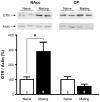Trichostatin A (TSA) facilitates formation of partner preference in male prairie voles (Microtus ochrogaster)
- PMID: 27074037
- PMCID: PMC4893910
- DOI: 10.1016/j.yhbeh.2016.04.001
Trichostatin A (TSA) facilitates formation of partner preference in male prairie voles (Microtus ochrogaster)
Abstract
In the socially monogamous prairie voles (Microtus ochrogaster), the development of a social bonding is indicated by the formation of partner preference, which involves a variety of environmental and neurochemical factors and brain structures. In a most recent study in female prairie voles, we found that treatment with the histone deacetylase inhibitor trichostatin A (TSA) facilitates the formation of partner preference through up-regulation of oxytocin receptor (OTR) and vasopressin V1a receptor (V1aR) genes expression in the nucleus accumbens (NAcc). In the present study, we tested the hypothesis that TSA treatment also facilitates partner preference formation and alters OTR and V1aR genes expression in the NAcc in male prairie voles. We thus observed that central injection of TSA dose-dependently promoted the formation of partner preference in the absence of mating in male prairie voles. Interestingly, TSA treatment up-regulated OTR, but not V1aR, gene expression in the NAcc similarly as they were affected by mating - an essential process for naturally occurring partner preference. These data, together with others, not only indicate the involvement of epigenetic events but also the potential role of NAcc oxytocin in the regulation of partner preference in both male and female prairie voles.
Keywords: Nucleus accumbens; Oxytocin; Partner preference; Prairie voles; Trichostatin A; Vasopressin.
Copyright © 2016 Elsevier Inc. All rights reserved.
Conflict of interest statement
The authors declare no conflict of interest.
Figures



Similar articles
-
Histone deacetylase inhibitors facilitate partner preference formation in female prairie voles.Nat Neurosci. 2013 Jul;16(7):919-24. doi: 10.1038/nn.3420. Epub 2013 Jun 2. Nat Neurosci. 2013. PMID: 23727821 Free PMC article.
-
Variation in oxytocin receptor density in the nucleus accumbens has differential effects on affiliative behaviors in monogamous and polygamous voles.J Neurosci. 2009 Feb 4;29(5):1312-8. doi: 10.1523/JNEUROSCI.5039-08.2009. J Neurosci. 2009. PMID: 19193878 Free PMC article.
-
Oxytocin administered centrally facilitates formation of a partner preference in female prairie voles (Microtus ochrogaster).J Neuroendocrinol. 1994 Jun;6(3):247-50. doi: 10.1111/j.1365-2826.1994.tb00579.x. J Neuroendocrinol. 1994. PMID: 7920590
-
Neurochemical regulation of pair bonding in male prairie voles.Physiol Behav. 2004 Nov 15;83(2):319-28. doi: 10.1016/j.physbeh.2004.08.024. Physiol Behav. 2004. PMID: 15488548 Review.
-
The ties that bond: neurochemistry of attachment in voles.Curr Opin Neurobiol. 2016 Jun;38:80-8. doi: 10.1016/j.conb.2016.04.011. Epub 2016 Apr 30. Curr Opin Neurobiol. 2016. PMID: 27131991 Free PMC article. Review.
Cited by
-
Role of oxytocin in the control of stress and food intake.J Neuroendocrinol. 2019 Mar;31(3):e12700. doi: 10.1111/jne.12700. Epub 2019 Mar 19. J Neuroendocrinol. 2019. PMID: 30786104 Free PMC article. Review.
-
Consequences of prenatal exposure to valproic acid in the socially monogamous prairie voles.Sci Rep. 2019 Feb 21;9(1):2453. doi: 10.1038/s41598-019-39014-7. Sci Rep. 2019. PMID: 30792426 Free PMC article.
-
Navigating Monogamy: Nonapeptide Sensitivity in a Memory Neural Circuit May Shape Social Behavior and Mating Decisions.Front Neurosci. 2017 Jul 11;11:397. doi: 10.3389/fnins.2017.00397. eCollection 2017. Front Neurosci. 2017. PMID: 28744194 Free PMC article. Review.
-
Paternal deprivation affects social behaviors and neurochemical systems in the offspring of socially monogamous prairie voles.Neuroscience. 2017 Feb 20;343:284-297. doi: 10.1016/j.neuroscience.2016.12.011. Epub 2016 Dec 18. Neuroscience. 2017. PMID: 27998780 Free PMC article.
-
Oxytocin and Social Relationships: From Attachment to Bond Disruption.Curr Top Behav Neurosci. 2018;35:97-117. doi: 10.1007/7854_2017_10. Curr Top Behav Neurosci. 2018. PMID: 28812266 Free PMC article. Review.
References
-
- Aragona BJ, Liu Y, Yu YJ, Curtis JT, Detwiler JM, Insel TR, Wang Z. Nucleus accumbens dopamine differentially mediates the formation and maintenance of monogamous pair bonds. Nat Neurosci. 2006;9:133–139. - PubMed
-
- Cho MM, DeVries AC, Williams JR, Carter CS. The effects of oxytocin and vasopressin on partner preferences in male and female prairie voles (Microtus ochrogaster) Behav Neurosci. 1999;113:1071–1079. - PubMed
-
- Insel TR, Hulihan TJ. A gender-specific mechanism for pair bonding: oxytocin and partner preference formation in monogamous voles. Behav Neurosci. 1995;109:782–789. - PubMed
-
- Insel TR, Preston S, Winslow JT. Mating in the monogamous male: behavioral consequences. Physiol Behav. 1995;57:615–627. - PubMed
MeSH terms
Substances
Grants and funding
LinkOut - more resources
Full Text Sources
Other Literature Sources
Research Materials

